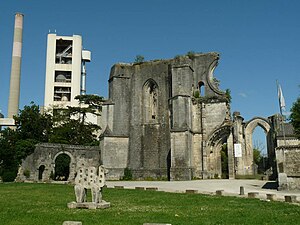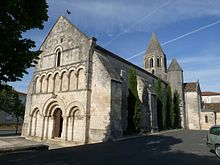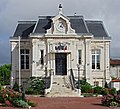La Couronne (Charente)
| La Couronne | ||
|---|---|---|

|
|
|
| region | Nouvelle-Aquitaine | |
| Department | Charente | |
| Arrondissement | Angoulême | |
| Canton | La Couronne | |
| Community association | Grand Angoulême | |
| Coordinates | 45 ° 36 ′ N , 0 ° 6 ′ E | |
| height | 31-137 m | |
| surface | 28.82 km 2 | |
| Residents | 7,732 (January 1, 2017) | |
| Population density | 268 inhabitants / km 2 | |
| Post Code | 16400 | |
| INSEE code | 16113 | |
 La Couronne - ruin of the abbey church and cement factory |
||
La Couronne is a commune and small town in the west of France with 7732 inhabitants (at January 1, 2017) and belongs to the Charente in the region Nouvelle-Aquitaine .
geography
La Couronne is located in the cultural landscape of the Angoumois about eight kilometers (driving distance) southwest of Angoulême . Three smaller tributaries of the Charente ( Boème , Charreau and Eaux-Claires ) flow through the territory of the municipality.
Population development
At the first census in France in 1793, La Couronne had about 2000 inhabitants; At the end of the 19th century there were around 3,500.
| year | 1968 | 1975 | 1982 | 1990 | 1999 | 2007 | 2016 |
| Residents | 5394 | 5901 | 6076 | 6295 | 6857 | 7037 | 7694 |
economy
For a long time La Couronne was shaped by agriculture. In the late Middle Ages, due to the abundance of water and forests in the region, a number of paper mills were established that were constantly modernized and some of them were in operation until the beginning of the 20th century. The only remaining paper mill ( Papeteries La Couronne ) specializes in envelopes and parcel packaging of all kinds. Nowadays, however, the city's main employer is the cement factory belonging to the Lafarge group .
history
The early history of La Couronne is closely linked to the former Notre-Dame Abbey (see below), which contributed significantly to the development of the place through the constant need for craftsmen, wagoners, day laborers, etc., who also had to be fed. During the Hundred Years War (1337–1453) the abbey and town were spared, but the Huguenot Wars (1562–1598) brought considerable devastation. The expulsion of Protestants from France under Louis XIV at the beginning of the 17th century led to inner calm, but also to economic stagnation.
Attractions
- At the beginning of the 12th century, a monk or priest named Lambert founded a monastery in the formerly swampy, but partially populated area of La Couronne ( Coronella ). In 1136, this Lambert was elected Bishop of Angoulême and, during his twelve-year term in office, richly endowed the abbey he founded with foundations and donations. At the end of the 12th century a new three-aisled abbey church, which was quite imposing for the time, was built in Gothic forms (201 feet long, 89 feet wide and 50 feet high); the foundation stone with the year and other historical facts was rediscovered during excavations in 1842. In 1183 the English King Henry II captured the church treasure, but work on the abbey church could continue; it was consecrated in 1201. During the French Revolution , the abbey was dissolved, the buildings were sold as a national property and used as a quarry. The still imposing ruins of the abbey church have been under monument protection since 1903 and are registered as Monument historique . Today the huge abbey site with its many buildings belongs to the Conseil Général de la Charente .
- The Romanesque parish church of Saint-Jean-Baptiste dates back in parts perhaps from the late 11th century; other parts can be clearly assigned to the 12th century. The octagonal crossing tower and the side stair tower have roofs made of stone or stone slabs ( lauzes ). The west facade with its beautiful three-part structure (portal zone, arcade zone and gable) is otherwise unadorned. The nave interior of the church with its five bays was later in the 12th century with one of transverse arches subjected barrel vault equipped, less so the risk of fire, the stability of the exterior walls, however, was affected; the latter were therefore additionally secured with powerful buttresses . The oldest part of the church, the choir, is separated from the nave by a choir arch ; the apse calotte and the inner wall of the apse were painted with frescoes in the historicizing style in the 19th century. The church was also recognized as a monument historique in 1903 and is now owned by the municipality.
- The Château de l'Oisellerie , a multi-towered, essentially Baroque building from the 16th to 18th centuries, now houses a viticulture and agriculture school. Also worth seeing is the entrance portal to the castle grounds with its split gable front and the two volutes above the side entrances. The building was registered as a monument historique in 1911 .
- The almost castle-like villa and the former paper mill of La Courade date from the 19th century and have been converted into a museum of paper production. The buildings are listed and have been classified as Monument historique since 2009 .
- A little outside of the village by a brook there is a wash house ( lavoir ) from the 19th century. It has open side walls resting on stone pillars, but a closed rear wall to protect it from prying eyes. In the past, the water of the stream was dammed by a wall.
Town Hall ( Hôtel de ville )
Twin town
Itzehoe in Schleswig-Holstein has been a twin town of La Couronne since 1988.
Personalities
- Léonard Jarraud (1848–1926), painter
literature
- Thorsten Droste : Poitou. Western France between Poitiers and Angoulême - the Atlantic coast from the Loire to the Gironde. DuMont, Cologne 1999, ISBN 3-7701-4456-2 , p. 244.
Individual evidence
- ↑ Abbaye Notre-Dame, La Couronne in the Base Mérimée of the French Ministry of Culture (French)
- ↑ Église Saint-Jean-Baptiste, La Couronne in the Base Mérimée of the French Ministry of Culture (French)
- ↑ Château de l'Oisellerie, La Couronne in the Base Mérimée of the French Ministry of Culture (French)
- ↑ Moulin de La Courade, La Couronne in the Base Mérimée of the French Ministry of Culture (French)
- ↑ Entry about the twin cities on the homepage of the city of Itzehoe.Retrieved on March 31, 2019, 3:25 pm
Web links
- City website (French)








